8.4 Disk Arrays
| only for RuBoard - do not distribute or recompile |
8.4 Disk Arrays
8.4.1 HP SureStore E Disk Array FC30
Figure 8-17. A3661A FC30 Disk Array
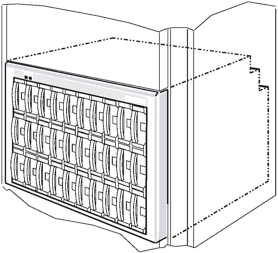
This Fibre Channel peripheral has substantial storage capacity. It holds up to 30 disk modules. Hewlett-Packard s highest capacity point is 18 gigabytes per disk module. This will increase with future releases. This disk array was designed specifically for use in Fibre Channel topologies.
It is a High Availability (HA) device because it employs redundant components such as:
-
disk modules
-
power supplies
-
controller units or storage processors (SP)
It is supported by the K-, D-, T- (600 only), and V-Class Hewlett-Packard Enterprise Servers running HP-UX 10.20 TFC or later. It has a 1.063 gigabit per second optical Fibre Channel link speed, and Fibre Channel Arbitrated Loop (FC-AL) topology is also supported.
8.4.2 HP SureStore E Disk Array FC60
Figure 8-18. A5277A FC60 Disk Array
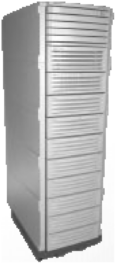
Hewlett-Packard s SureStore E Disk Array FC60 is designed to deliver a large volume of high-performance, high-availability disk storage. The Disk Array FC60 combines Fibre Channel speed, RAID protection, and multidrive capacity.
The Disk Array FC60 is five times faster than previous storage solutions and holds twice as much data.
8.4.2.1 Features and Benefits
-
Fibre Channel communication for speed and reliability
-
Modular construction for flexibility of configuration
-
Expandable storage for capacity up to 1 TB
-
High throughput
-
User -configurable RAID
-
10,000-rpm disk speed
-
120- hour battery backup of cache for data safety
-
Hot-swappable components for minimal service interruption
8.4.2.2 RAID
The Array Manager 60 management software lets you choose the important RAID parameters specifically to suit the environment. You can set the partition size and RAID levels, using either the graphical interface for easy selection or the scriptable command line interface that automates management of large numbers of disk arrays.You can configure the system for maximum availability and continued peak performance in the event of a disk failure. This yields a disk subsystem with a high degree of performance and predictability, regardless of activity elsewhere in the system. Or you can configure for maximum storage capacity with minimum expense.
8.4.2.3 I/O- Intensive Applications
The high-speed disks in the Disk Array FC60 rotate at 10,000 rpm, enhancing I/O performance, especially in computing applications that involve large numbers of small data transfers. This makes the Disk Array FC60 a good choice for use in I/O-intensive applications: data warehousing, OLTP, ERP, and file serving.
8.4.2.4 Inter nal Batteries
As with any HA installation, an uninterruptible power supply is recommended for use with the Disk Array FC60. However, internal batteries in the disk array maintain information in the controller cache for up to 120 hours. This assures no data loss even in the event of a complete loss of electrical power over a long weekend .
8.4.2.5 Zero-Downtime Maintenance
All data in the Disk Array FC60 is RAID-configured, so if any drive fails, no data is lost and system operation continues with no interruption. Power supplies and fans are redundant, so the system continues to operate even if one fails. Moreover, array controllers, disk drives , power supplies, fans, and batteries are all hot-swappable, so repairs won t affect the system s high availability.
8.4.2.6 Throughput
The FC60 has a peak throughput of 100 MBps on each channel, and sequential transfer rates of up to 200 MBps for dual controller configurations. (Although actual performance will vary depending on the application and the server environment, the FC60 has achieved actual measured performance as high as 170 MBps in the laboratory, and 130 to 170 MBps for a variety of real-world configurations.)
8.4.2.7 Scalability
The FC60 is designed to be extremely flexible. You can begin with a small amount of storage and augment it as the need for capacity grows.
Figure 8-19. Block Diagram of the FC60

The Disk Array FC60 consists of a controller enclosure and up to six disk enclosures, all of which can be mounted in standard 19 computer equipment racks. The controller enclosure holds one or two array controllers, each with 256 megabytes of cache memory. The controller enclosure is connected to each of the disk enclosures by way of one or two Ultra2 SCSI cables.
Each disk enclosure can hold up to 10 disk drives, which can be either 9.1-or 18.2-gigabyte models. With a full complement of 18.2-gigabyte drives, a single Disk Array FC60 can provide more than 1 TB of data storage.
8.4.3 HP SureStore E Disk Array XP256
The HP SureStore E Disk Array XP256 provides high-capacity, high-speed mass storage, with continuous data availability, ease of service, scalability, and connectivity.
Figure 8-20. The XP256 Disk Array
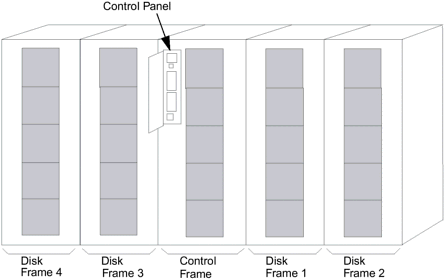
The XP256 disk array can be attached to multiple open -system environments such as HP-UX, Windows NT, Solaris, AIX, etc. The disk array is designed to handle very large databases, data warehousing applications, and data mining applications.
This disk array can have up to 32 SCSI ports. It also supports Fibre Channel connections with data transfer rates of up to 100 MBps. Each Fibre Channel channel adapter (CA) supports up to 16 Fibre Channel ports. This makes the disk array ideal for clustered configurations of open-system servers.
8.4.4 Features
8.4.4.1 Continuous Data Availability
The disk array is the first RAID disk array to provide truly continuous data availability. It is designed for nonstop operation and continuous access to all user data. The disk array has no single point of component failure. It is not expected to fail in any way that would interrupt user access to data.
The disk array has component and function redundancy, providing full fault-tolerance for disk array microprocessors, control storage, control and data buses, power supplies, and cooling fans. The disk array can sustain multiple component failures and still continue to provide full access to stored data.
While access to user data is never compromised, the failure of a key component can degrade disk array performance.
8.4.4.2 Nondisruptive Ser vice and Upgrades
Monitoring software detects failed disk drives and notifies the HP support center automatically so a service representative can replace the disk drive.
All hardware subassemblies can be removed, serviced, repaired, or replaced nondisruptively during disk array operation. All microcode upgrades can be performed during normal disk array operations, using the array s built-in service processor (SVP) or the facilities of the host. Alternate pathing can be achieved by host fail-over software and/or alternate SCSI paths. The disk array provides up to 32 SCSI ports to accommodate alternate pathing for attachment to a host.
8.4.4.3 Connectivity
SCSI Connectivity. The disk array can be configured with up to four pairs of Ultra-SCSI four-port adapters for a total of 32 ports. Each adapter provides four concurrent data transfers at rates of up to 40 MBps, for a total data transfer rate of 160 MBps. Each SCSI port can support up to 15 SCSI target IDs (TIDs), and each SCSI TID can address eight logical units (LUNs), for a total of 120 LUNs per SCSI port.
Fibre Channel Connectivity. A disk array can be configured with a maximum of four channel adapters which can each support 16 Fibre Channel ports. Each port is assigned a unique TID and can support eight LUNs. The disk array can support up to 128 LUNs attached through Fibre Channel. Fibre Channel provides data transfer rates up to 100 MBps. The disk array can support Fibre Channel Arbitrated Loop (FC-AL) and fabric topologies.
8.4.4.4 Scalability
The nonvolatile cache can also be configured from 4 GB to 16 GB in 1 GB increments . The disk array s storage capacity can be increased from 17 GB to a maximum of 9.0 TB. Disk drive and cache upgrades can be performed without interrupting user access to data and with minimal impact on the performance of the disk array.
8.4.5 Physical Components
The disk array consists of the following major hardware components:
-
One Disk Control frame. The controller cabinet contains the control panel, Fibre Channel connection hardware, SCSI connection hardware, service processor (SVP), and control components for the disk array.
-
One to four Disk Array frames . These cabinets contain the disk drives.
-
One service processor (SVP). The SVP is an internally mounted laptop computer used for maintenance. It is located in the controller cabinet. The SVP is used by an HP service representative.
-
One optional remote console (RC) PC. The remote console PC is attached to the disk array by an internal local area network (LAN). The remote console PC runs applications that monitor and manage disk array operations.
Figure 8-21. XP256 Disk Array Components
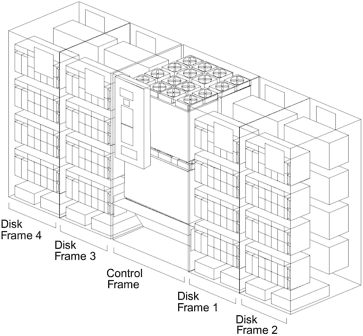
8.4.5.1 Disk Control Frame
The key features and components of the disk control frame are redundant controllers and redundant power supplies. There is no active single point of failure. All control frame components can be repaired or replaced without interrupting access to user data.
8.4.5.2 Disk Array Frame
The disk array frames contain the physical disk drives, including the disk groups and the dynamic spare disk drives. The disk array can be configured with up to four disk cabinets to provide a maximum storage capacity of 9.0 TB. One disk array frame is required. The second, third, and fourth frames are optional. The first and second disk array frames are attached to the right side of the control frame. The third and fourth are attached to the left side of the control frame.
The disk array uses 3.5-inch disk drives, with a variety of available capacity points. Disk drives can be replaced without disrupting user activity. The disk array uses diagnostic and dynamic scrubbing techniques that detect and correct disk errors.
For both RAID-5 and RAID-1 array groups, any spare disk drive can back up any other disk drive of the same capacity, anywhere in the disk array, even if the failed disk and the spare disk are in different array domains. The disk array can be configured with a minimum of one and a maximum of 16 spare disk drives.
8.4.5.3 Service Processor (SVP)
The disk array comes with a built-in laptop-style PC called the service processor (SVP). The SVP is integrated into the control frame and is used only by an HP service representative.
The SVP is used to configure, maintain, and upgrade the disk array. The SVP also collects performance data for key components of the disk array for diagnostic testing and analysis. The SVP does not have access to any user data stored on the disk array.
8.4.5.4 Remote Console PC
The remote console PC runs a main remote control application and other standard and optional software to manage and monitor the disk array. The remote console PC is connected to one or more disk arrays (up to 8) using a special LAN, separate from the regular LAN.
The specific hardware requirements for the remote console PC (processor speed, storage capacity, memory) will vary depending on the optional software to be used and the number of disk arrays to be attached.
The Remote Control software for the remote console PC does not have access to any user data stored on the disk array.
8.4.6 Monitoring and Repor ting
The disk array has a maintenance support application that monitors the operation of the disk array at all times, collects hardware status and error data, and transmits this data through a modem to the HP support center.
The support center analyzes the data and implements corrective action, if necessary. In the unlikely event of a component failure, the maintenance support application calls the support center immediately to report the failure. This automatic error/failure detection and reporting does not require any action on the part of the user.
In this way most disk array problems can be identified and fixed prior to actual failure. With the redundancy features of the disk array, it will remain operational even if one or more components fail.
The maintenance support application requires a dedicated telephone line. The maintenance support application does not have access to any user data stored on the disk array.
8.4.7 Optional Software
HP provides a number of optional software applications to increase data accessibility and enable continuous user data access.
8.4.7.1 HP SureStore E Perfor mance Manager XP
HP SureStore E Performance Manager XP (PMXP) is an optional performance and usage monitoring application for the disk array. PMXP runs on the remote console PC and can monitor as many as eight disk arrays on the disk array internal LAN. PMXP monitors hardware performance, cache statistics, and I/O statistics of the attached disk arrays and displays real-time and historical data as graphs.
8.4.7.2 HP SureStore E Remote Control XP
HP SureStore E Remote Control XP is an optional software application that runs on the remote console PC. It has a primary function of reporting Remote System Information Messages (R-SIMs). In addition, it is the base software that allows a number of additional optional packages to run.
Those packages include the following:
HP SureStore E LUN Configuration Manager XP. The HP SureStore E LUN Configuration Manager XP allows open-system users to define SCSI paths, define the SCSI/FC-to-logical device (LDEV) mapping for all LUNs, and configure arbitrated-loop and fabric FC topologies. It also allows users to create expanded-size LUNs, permitting host access to the data on the disk array using fewer logical units.
SNMP. The Microsoft simple network management protocol (SNMP) is a part of the TCP/IP protocol suite that supports maintenance functions for the disk arrays. SNMP transfers management information and R-SIMs between the SNMP manager (on the open-system server) and the SNMP agent (on the remote console PC). The SNMP agent performs error reporting operations requested by the SNMP manager, for up to eight disk array models.
HP SureStore E Cache LUN XP. This application allows users to place data in and remove data from cache to improve disk array performance when the system accesses frequently used data.
HP SureStore E Cache LUN XP enables users to store specific high-usage data in cache memory. Cache-resident data is available at host data transfer speeds for both read and write operations. HP SureStore E Cache LUN XP can be used in conjunction with custom volume size (CVS) to provide even higher data access performance than when either of these features is used individually.
Custom Volume Size (CVS). Custom Volume Size allows the user to configure custom-size volumes (CVs), which are smaller than normal volumes . CVS improves data access performance by reducing logical device contention , as well as host I/O queue times, which can occur when several frequently accessed files are located on the same volume.
HP SureStore E Secure Manager XP. This software is for LUN security on the array. The application allows the assignment of selected LUNs to selected hosts, and hides LUNs from hosts not associated with the LUNs. HP SureStore E Secure Manager XP is executed from the remote console PC.
HP SureStore E AutoLUN XP. AutoLUN enables the optimization of data storage and retrieval on the disk array. AutoLUN monitors and provides detailed information on the physical disk drive usage of the disk array and enables you to optimize the logical volume allocation and RAID level configuration (RAID-1, RAID-5) of the disk array.
8.4.7.3 HP SureStore E Continuous Access XP
HP SureStore E Continuous Access XP enables users to copy data between disk arrays as far as 1600 km (1000 miles) apart. HP SureStore E Continuous Access XP provides synchronous and semisynchronous copy modes and can be used for data backup, disaster recovery planning, and/or data duplication. The primary LUNs are available for read and write operations during all normal remote copy operations.
8.4.7.4 HP SureStore E Business Copy XP
HP SureStore E Business Copy XP provides a quick and easy way to create an internal copy of a volume for a wide variety of purposes, such as application testing, offline backup, and Euro currency conversion testing. When used in conjunction with HP SureStore E Continuous Access XP, HP SureStore E Business Copy XP allows users to maintain multiple copies of critical data.
8.4.7.5 HP SureStore E Data Exchange XP
HP SureStore E Data Exchange XP is an optional feature of the HP SureStore E Disk Array XP256. It enables data stored on a multiplatform disk array (one that is connected to both a mainframe and open-system servers) to be converted and transferred between mainframe-based files and open-system files.
8.4.7.6 HP SureStore E Resource Manager XP
The HP SureStore E Resource Manager XP application allows mainframe data and open-system data to coexist in the same disk array. This reduces and optimizes storage maintenance and management overhead.
Figure 8-22. Resource Manager
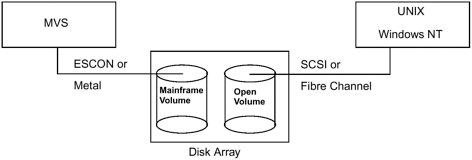
8.4.7.7 HP SureStore E RAID Manager XP
This application is the host-based component of the HP SureStore E Business Copy XP and HP SureStore E Continuous Access XP applications. It gives the system administrator command line control over these programs. It is also used by HP SureStore E Continuous Access XP for local and remote host communication.
| only for RuBoard - do not distribute or recompile |
EAN: 2147483647
Pages: 88